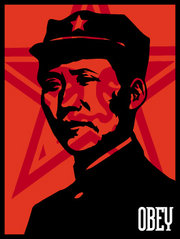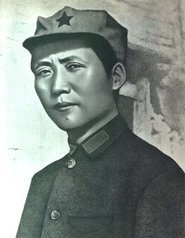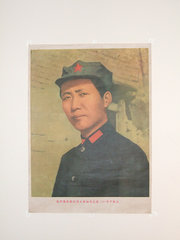Young Mao (Difference between revisions)
From The Giant: The Definitive Obey Giant Site
m |
m |
||
| Line 49: | Line 49: | ||
| − | + | By October 1934, he had them surrounded, prompting them to engage in the "Long March," a retreat from Jiangxi in the southeast to Shaanxi in the northwest of China. It was during this 9,600 kilometer (5,965 mile), year-long journey that Mao emerged as the top Communist leader, aided by the Zunyi Conference and the defection of Zhou Enlai to Mao's side. At this Conference, Mao entered the Standing Committee of the Politburo of the Communist Party of China. | |
From his base in Yan'an, Mao led the Communist resistance against the Japanese in the Second Sino-Japanese War (1937-1945). Mao further consolidated power over the Communist Party in 1942 by launching the Cheng Feng, or "Rectification" campaign against rival CPC members such as Wang Ming, Wang Shiwei, and Ding Ling. Also while in Yan'an, Mao divorced He Zizhen and married the actress Lan Ping, who would become known as Jiang Qing. | From his base in Yan'an, Mao led the Communist resistance against the Japanese in the Second Sino-Japanese War (1937-1945). Mao further consolidated power over the Communist Party in 1942 by launching the Cheng Feng, or "Rectification" campaign against rival CPC members such as Wang Ming, Wang Shiwei, and Ding Ling. Also while in Yan'an, Mao divorced He Zizhen and married the actress Lan Ping, who would become known as Jiang Qing. | ||
| Line 57: | Line 57: | ||
In 1944, the Americans sent a special diplomatic envoy, called the Dixie Mission, to the Communist Party of China. According to Edwin Moise, in Modern China: A History 2nd Edition: | In 1944, the Americans sent a special diplomatic envoy, called the Dixie Mission, to the Communist Party of China. According to Edwin Moise, in Modern China: A History 2nd Edition: | ||
| − | Most of the Americans were favourably impressed. The CPC seemed less corrupt, more unified, and more vigorous in its resistance to Japan than the Guomindang. United States fliers shot down over North China...confirmed to their superiors that the CPC was both strong and popular over a broad area. In the end, the contacts with the USA developed with the CPC led to very little. | + | ''Most of the Americans were favourably impressed. The CPC seemed less corrupt, more unified, and more vigorous in its resistance to Japan than the Guomindang. United States fliers shot down over North China...confirmed to their superiors that the CPC was both strong and popular over a broad area. In the end, the contacts with the USA developed with the CPC led to very little.'' |
| + | |||
Then again, modern commentators have refuted such claims. Amongst others, Willy Lam stated that during the war with Japan: | Then again, modern commentators have refuted such claims. Amongst others, Willy Lam stated that during the war with Japan: | ||
''The great majority of casualties sustained by Chinese soldiers were borne by KMT, not Communist divisions. Mao and other guerrilla leaders decided at the time to conserve their strength for the "larger struggle" of taking over all of China once the Japanese Imperial Army was decimated by the U.S.-led Allied Forces.'' | ''The great majority of casualties sustained by Chinese soldiers were borne by KMT, not Communist divisions. Mao and other guerrilla leaders decided at the time to conserve their strength for the "larger struggle" of taking over all of China once the Japanese Imperial Army was decimated by the U.S.-led Allied Forces.'' | ||
| − | + | The US continued to support Chiang Kai-shek, now openly against the Communist Red Army (led by Mao Zedong) in the civil war for control of China. The US support was part of its view to contain and defeat "world communism." Likewise, the Soviet Union gave quasi-covert support to Mao (acting as a concerned neighbor more than a military ally, to avoid open conflict with the US) and gave large supplies of arms to the Communist Party of China, although newer Chinese records indicate the Soviet "supplies" were not as large as previously believed, and consistently fell short of the promised amount of aid. | |
On January 21, 1949, Kuomintang forces suffered massive losses against Mao's Red Army. In the early morning of December 10, 1949, Red Army troops laid siege to Chengdu, the last KMT-occupied city in mainland China, and Chiang Kai-shek evacuated from the mainland to Taiwan (Formosa) that same day. | On January 21, 1949, Kuomintang forces suffered massive losses against Mao's Red Army. In the early morning of December 10, 1949, Red Army troops laid siege to Chengdu, the last KMT-occupied city in mainland China, and Chiang Kai-shek evacuated from the mainland to Taiwan (Formosa) that same day. | ||
Latest revision as of 19:05, 17 September 2006
From Wikipedia:
Contents |
[edit] Short Bio
Mao Zedong (December 26, 1893 – September 9, 1976) (also Mao Tse-Tung in Wade-Giles transliteration) was a Chinese Marxist military and political leader, who led China's communist revolution after decades of foreign occupation and civil war in the 20th century. Following the Communist Party of China’s military victory over the Kuomintang in the Chinese Civil War, Mao announced the establishment of the People’s Republic of China on October 1, 1949 in Beijing.
Mao pursued the ideal of strong and prosperous China, endeavoring to build a modern, industrialized nation. However, the failings of Mao's most significant socio-political programs — including the Anti-Rightist Campaign, the Great Leap Forward, and the Cultural Revolution — are widely criticized.
[edit] Early Life
The eldest child of a moderate family, Mao Zedong was born on December 26, 1893 in a village called Shaoshan in Xiangtan county (湘潭縣), Hunan province, and thus spoke Xiang rather than Mandarin. His ancestors had migrated from Jiangxi province during the Ming Dynasty, married indigenous women, and had settled there as farmers for generations.
During the 1911 Revolution, Mao served for months in a local regiment in Hunan. However, having felt unaccustomed to a life of military service, he returned to school in Changsha, where he realized the importance of both health and knowledge.
Having graduated from the First Provincial Normal School of Hunan in 1918, Mao traveled with Professor Yang Changji, his high school teacher, also his future father-in-law, to Beijing during the May Fourth Movement in 1919.
Professor Yang held a faculty position at National Peking University. Because of Yang's recommendation, Mao worked as an assistant librarian at the University with Li Dazhao as curator of the library. At the same time, Mao registered as a part-time student at Beijing University and audited many lectures and seminars by some famous intellectuals, such as Chen Duxiu, Hu Shi, and Qian Xuantong, etc. Over his stay in Beijing, he read as much as possible, which introduced him for the first time to Communist theories. In the meantime, he married Yang Kaihui, Professor Yang Changji's daughter and also his fellow student, despite an existing marriage arranged by his father at home. Mao had never acknowledged this marriage.
Later, Mao turned down an opportunity to study in France because of poverty. Later he claimed that it was because he firmly believed that China's problems could be studied and resolved only within China. As distinct from his contemporaries, Mao went the opposite direction, studying the peasant majority of China's population where he began his life as a professional revolutionist.
On July 23, 1921, Mao, at the age of 27, attended the first session of the National Congress of the Communist Party of China in Shanghai . Two years later, he was elected one of the five commissars of the Central Committee of the Communist Party of China during the third session of the Congress.
Mao stayed for a while in Shanghai, an important city that the CPC emphasised for the Revolution. But after the Party had encountered major difficulties in organizing labor union movements, and relations with its nationalist ally, the Kuomintang had become poor, Mao was disillusioned at the revolution there and moved back to his home village of Shaoshan. During his stay at home, Mao rekindled his interest in the revolution, having been informed of the 1925 uprisings in Shanghai and Guangzhou. He then went to Guangdong, the base of the Kuomintang, as a return of his political ambitions. During his stay there, Mao took part in the preparations for the second session of the National Congress of Kuomintang.
In early 1927, Mao returned to Hunan where, in an urgent meeting held by the Communist Party of China, he made a report based upon his investigations and study of the recent peasant uprisings in the wake of the Northern Expedition. This report is considered the initial and decisive step toward the successful application of Mao's revolutionary theories in China.
[edit] War and Revolution
In 1927 Mao conducted the famous Autumn Harvest Uprising in Changsha, Hunan, as commander-in-chief. The army led by Mao, entitled Revolutionary Army of Workers and Peasants, was defeated and scattered after some fierce battles. Afterwards the exhausted troops were forced to leave Hunan for Sanwan, Jiangxi, where Mao re-organized the scattered soldiers, rearranging them from a military division into a smaller regiment. And Mao ordered that each company must have a party branch office with a commissar as its leader who would give political instructions based upon superior mandates. This military rearrangement in Sanwan, Jiangxi initiated the CPC's absolute control over its military force and has been considered to have the most fundamental and profound impact upon the Chinese revolution. Later on, they moved to Jinggang Mountains, Jiangxi.
On the Jinggang mountains, Mao persuaded two local insurgent leaders who pledged their allegiance to him. And there Mao rejoined his army with that of Zhu De. Thus he created the Workers' and Peasants' Red Army of China, Red Army in short. (the Fourth Front of Workers' and Peasants' Red Army of China).
From 1931 to 1934, Mao helped establish the Soviet Republic of China and was elected Chairman of this small republic among the mountainous areas in Jiangxi. Here, Mao was married to He Zizhen. His wife Yang Kaihui, who sacrificed for the revolution, had been arrested and executed in 1930, just three years after their departure.
In Jiangxi, Mao's authoritative domination, especially that of the military force was challenged by the Jiangxi branch of the CPC and military officers. Mao's opponents, among whom the most prominent was Li Wenlin, the founder of the CPC's branch and Red Army in Jiangxi, were against Mao's land policies and proposals to reform the local party branch and army leadership. Mao reacted first by accusing the opponents of opportunism and kulakism and then set off a series of systematic suppressions of them. Later the suppressions were turned into bloody physical elimination. The estimated number of the victims amounted to several thousands. Through the so-called revolutionary terrorism, or red terrorism, Mao's authority and domination in Jiangxi was secured and reassured. However, this had left unforgettable scars on Mao's mind.
Mao, with the help of Zhu De, built a modest but effective army, undertook experiments in rural reform and government, and provided refuge for Communists fleeing the rightist purges in the cities. Mao's methods are normally referred to as Guerrilla warfare; but he himself made a distinction between guerrilla warfare (youji zhan) and Mobile Warfare (yundong zhan).
Mao's Guerrilla Warfare and Mobile Warfare was based upon the fact of the poor armament and military training of the red army which consisted mainly of impoverished peasants, who, however, were all encouraged by revolutionary passions and aspiring after a communist utopia.
Around 1930, there had been more than ten regions, usually entitled "soviet areas", under control of the CPC. And the number of Red Army soldiers ran to no less than a hundred thousand. The prosperity of "soviet areas" startled and worried Chiang Kai-shek, chairman of the Kuomintang government, who waged five waves of besieging campaigns against the "central soviet area". More than one million Kuomintang soldiers were involved in these five campaigns, four out of which were defeated by the red army led by Mao.
Under increasing pressures from the KMT encirclement campaigns, there was a struggle for power within the Communist leadership. Mao was removed from his important positions and replaced by individuals (including Zhou Enlai) who appeared loyal to the orthodox line advocated by Moscow and represented within the CPC by a group known as the 28 Bolsheviks.
By October 1934, he had them surrounded, prompting them to engage in the "Long March," a retreat from Jiangxi in the southeast to Shaanxi in the northwest of China. It was during this 9,600 kilometer (5,965 mile), year-long journey that Mao emerged as the top Communist leader, aided by the Zunyi Conference and the defection of Zhou Enlai to Mao's side. At this Conference, Mao entered the Standing Committee of the Politburo of the Communist Party of China.
From his base in Yan'an, Mao led the Communist resistance against the Japanese in the Second Sino-Japanese War (1937-1945). Mao further consolidated power over the Communist Party in 1942 by launching the Cheng Feng, or "Rectification" campaign against rival CPC members such as Wang Ming, Wang Shiwei, and Ding Ling. Also while in Yan'an, Mao divorced He Zizhen and married the actress Lan Ping, who would become known as Jiang Qing.
During the Sino-Japanese War, Mao Zedong's strategies were opposed by both Chiang Kai-shek and the United States. The US regarded Chiang as an important ally, able to help shorten the war by engaging the Japanese occupiers in China. Chiang, in contrast, sought to build the ROC army for the certain conflict with Mao's communist forces after the end of World War II. This fact was not understood well in the US, and precious lend-lease armaments continued to be allocated to the Kuomintang. In turn, Mao spent part of the war (as to whether it was most or only a little is disputed) fighting the Kuomintang for control of certain parts of China. Both the Communists and Nationalists have been criticised for fighting amongst themselves rather than allying against the Japanese Imperial Army.
In 1944, the Americans sent a special diplomatic envoy, called the Dixie Mission, to the Communist Party of China. According to Edwin Moise, in Modern China: A History 2nd Edition:
Most of the Americans were favourably impressed. The CPC seemed less corrupt, more unified, and more vigorous in its resistance to Japan than the Guomindang. United States fliers shot down over North China...confirmed to their superiors that the CPC was both strong and popular over a broad area. In the end, the contacts with the USA developed with the CPC led to very little.
Then again, modern commentators have refuted such claims. Amongst others, Willy Lam stated that during the war with Japan:
The great majority of casualties sustained by Chinese soldiers were borne by KMT, not Communist divisions. Mao and other guerrilla leaders decided at the time to conserve their strength for the "larger struggle" of taking over all of China once the Japanese Imperial Army was decimated by the U.S.-led Allied Forces.
The US continued to support Chiang Kai-shek, now openly against the Communist Red Army (led by Mao Zedong) in the civil war for control of China. The US support was part of its view to contain and defeat "world communism." Likewise, the Soviet Union gave quasi-covert support to Mao (acting as a concerned neighbor more than a military ally, to avoid open conflict with the US) and gave large supplies of arms to the Communist Party of China, although newer Chinese records indicate the Soviet "supplies" were not as large as previously believed, and consistently fell short of the promised amount of aid.
On January 21, 1949, Kuomintang forces suffered massive losses against Mao's Red Army. In the early morning of December 10, 1949, Red Army troops laid siege to Chengdu, the last KMT-occupied city in mainland China, and Chiang Kai-shek evacuated from the mainland to Taiwan (Formosa) that same day.
Images of Mao, and Communist Chinese propoganda in general, have been significant influences on Shepard's work. These images of a young Mao, taken in Northern Senshi in 1935-1936, serve as the model of Shepard's 1998 work, Mao.
 1998's Mao |
© Copyright |
|---|
| This page contains an image or images of drawings, paintings, photographs, prints, or other two-dimensional works of art, for which the copyright is presumably owned by either the artist who produced the image, the person who commissioned the work, or the heirs thereof. It is believed that the use of low-resolution images of works of art for critical commentary on the work in question, the artistic genre or technique of the work of art, or the school to which the artist belongs on the English-language website thegiant.org, hosted on servers in the United States, qualifies as fair use under United States copyright law. |


